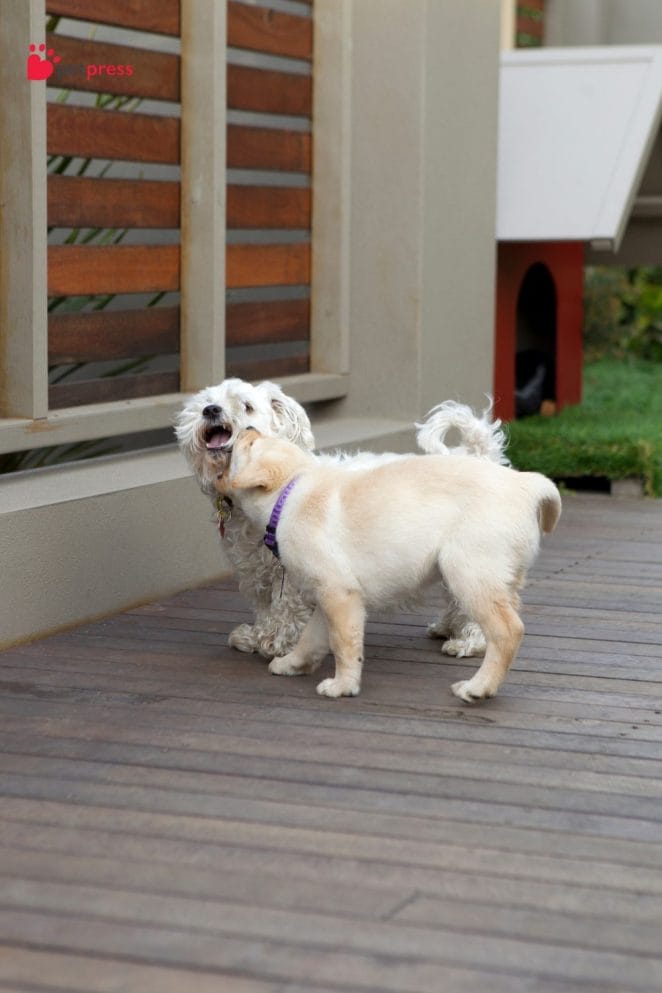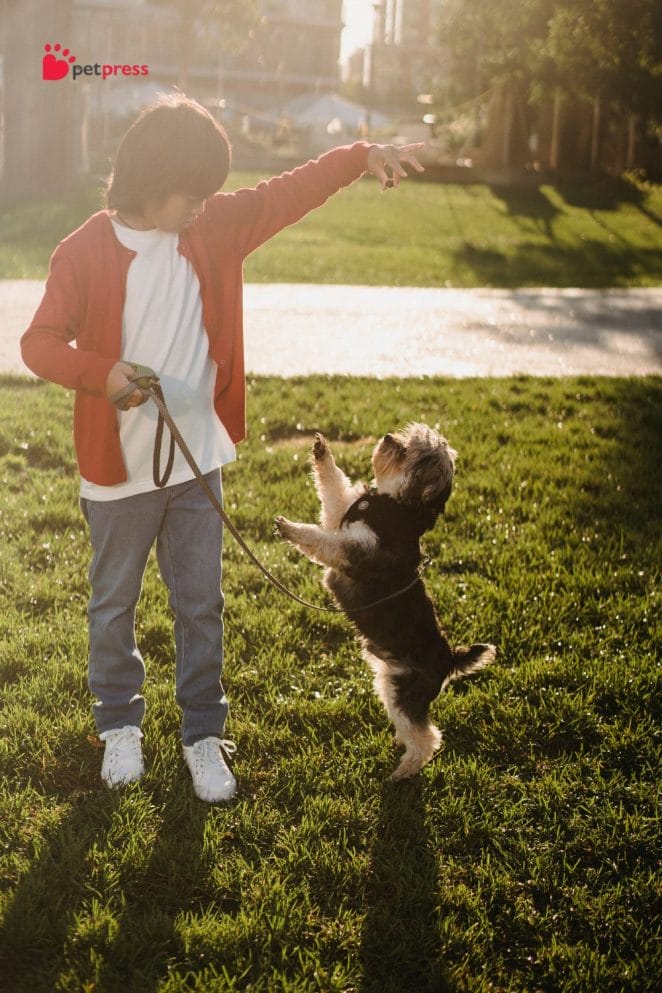
Dog aggression towards kids is a topic no pet owner wants to face, yet it’s crucial. Understanding and addressing it early can make all the difference. It’s not just about safety; it’s about fostering a loving bond between your furry family member and your children.
This article aims to arm you with tips and strategies to stop potential aggression in its tracks. We want your home to be a place of peace, not worry. Here, you’ll find practical advice that any pet owner can implement to keep both kids and dogs happy and safe.
Understanding Dog Aggression
Dog aggression towards kids can stem from several places, and it’s not always because a dog is ‘mean.’ Let’s dive into why our furry friends might show aggression and the signs to watch for.
The Roots of Aggression
- Fear: Just like any of us, dogs get scared. A child’s quick movements or loud voices can startle them, leading to fear-based aggression.
- Territorial Behavior: Dogs naturally protect their space. If a kid invades what a dog considers its territory, it might respond aggressively.
- Lack of Socialization: Dogs that aren’t used to being around kids may react negatively. Socializing them early with children can help prevent aggression.
Understanding these triggers is the first step in preventing dog aggression towards kids. Each dog has its own personality and history, so being mindful of their comfort levels is key.
Signs of Aggression
Awareness of how dogs communicate discomfort is crucial. Here are some signs that a dog might be heading towards aggression:
- Growling: It’s a clear sign your dog is uncomfortable. It’s their way of saying, “please back off.”
- Snapping: A more urgent warning sign. If your dog snaps at the air near a child, it’s time to intervene.
- Staring: A fixed, hard stare at a child is another sign of a dog feeling threatened or uneasy.
Recognizing these signs early can prevent a scary situation. It’s all about creating a safe environment for both your kids and your dog.

8 Ways to Stop Dog Aggression Towards Kids
1. Early Socialization
Getting your dog comfortable with a variety of people, including kids, is key. Start this process early. Puppies are especially open to new experiences. By introducing them to children in a controlled, positive way, you’re laying the groundwork for lifelong friendships.
2. Regular Training
Training is more than just tricks; it’s about communication. Teach your dog commands like “sit,” “stay,” and “leave it.” These can diffuse tense situations before they escalate. Regular training sessions also strengthen the bond between you and your dog, making them more likely to listen in all situations.
3. Create Safe Spaces
Everyone needs a little alone time, dogs included. Set up a quiet spot where your dog can retreat when they feel overwhelmed. This is crucial in a busy household. It teaches your dog there’s always a safe place, reducing stress and the potential for aggression.
4. Educate Your Kids
It’s a two-way street. Children need to learn how to interact safely and respectfully with dogs. Simple rules like not pulling tails or disturbing a sleeping dog can prevent misunderstandings. Make teaching these rules a fun game, and it’ll stick better.
5. Monitor Playtime
Always keep an eye on interactions between your dog and children, even if your dog is usually gentle. It helps prevent rough play that could lead to accidents. If play gets too wild, calmly separate them and give everyone a chance to settle down.
6. Use Positive Reinforcement
Focus on rewarding good behavior rather than punishing the bad. Treats, praise, and petting, when your dog is calm around kids, reinforce that peaceful interactions are beneficial. This approach builds trust and makes obedience training more effective.
7. Seek Professional Help if Needed
There’s no shame in asking for help. If you notice signs of aggression, consult a professional dog trainer or behaviorist. They can provide personalized strategies tailored to your dog’s needs. Early intervention can prevent serious issues later on.
8. Consistency is Crucial
Everyone in the household should be on the same page regarding rules and training. If one person allows something that another doesn’t, it can confuse your dog and lead to behavioral problems. Consistency makes your dog feel secure and understand what’s expected of them.

The Role of the Family to Manage Dog Aggression
The whole family plays a crucial role in shaping a dog’s behavior, especially when it comes to preventing aggression towards kids. Consistency in how everyone interacts and trains the dog lays the foundation for trust and understanding, making your furry friend feel secure and loved in its pack.
Consistency is Key
Imagine if each family member spoke a different language to your dog. Confusing, right? That’s why consistency is so important. By using the same commands, rewards, and disciplinary actions, your dog learns what’s expected faster, reducing confusion and potential frustration. It’s all about teamwork!
Education and Awareness
Understanding dog body language is like unlocking a secret code to your pet’s feelings. Families can learn a lot by observing their dog’s posture, tail wagging, and ear positions. This knowledge helps in recognizing stress or discomfort early, preventing any mishaps with kids. Websites, books, and even workshops are great resources for learning these canine cues.
By becoming fluent in “dog,” you’ll be able to spot when your four-legged pal needs a break from playtime or is getting overwhelmed. Sharing what you learn with your kids not only keeps them safe but also teaches them respect and empathy for their furry siblings.
Being proactive, consistent, and educated as a family unit strengthens the bond with your dog and ensures a harmonious home where everyone, on two legs or four, feels understood.
Conclusion
We’ve explored how understanding the roots of dog aggression and recognizing the early signs can set the stage for a peaceful home. Training, early socialization, and establishing clear boundaries are key.
Remember, intervening early with professional help and creating a safe space for both kids and dogs are vital steps. Consistency from the entire family in training and education about dog body language can prevent misunderstandings.
Preventing dog aggression towards kids is definitely within reach. It takes proactive measures, patience, and ongoing education. Your efforts today will foster a lifelong friendship between your child and your dog.

FAQs for Dog Aggression Towards Kids
Watch for growling, baring teeth, stiff body language, and a fixed gaze. These signs indicate your dog is uncomfortable and may escalate if not addressed promptly.
The earlier, the better! Puppies are most receptive to new experiences between 3 to 14 weeks of age. Gentle introductions during this window can pave the way for lifelong friendships.
Educate them on respecting the dog’s space, avoiding rough play, and recognizing when the dog wants to be left alone. Mutual respect is the foundation of a safe relationship.
Aggression isn’t breed-specific but can be influenced by genetics, upbringing, and environment. Focusing on positive reinforcement and socialization is crucial for all dogs.
Create a designated safe space for your dog to retreat to when overwhelmed. Teach children to recognize this space as off-limits, ensuring peace for everyone in the household.


GIPHY App Key not set. Please check settings